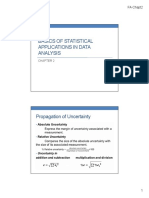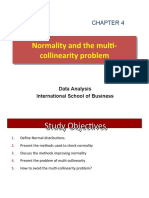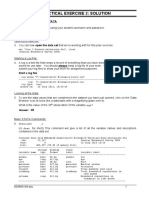0 ratings0% found this document useful (0 votes)
33 views365 Data Science - Statistics: Glossary Section Lesson Word
365 Data Science - Statistics: Glossary Section Lesson Word
Uploaded by
Anuj KaushikThe document defines statistical terms across multiple sections. It provides definitions for common statistical concepts like population, sample, measures of central tendency, and types of data. The glossary contains over 50 terms and their meanings to help explain foundational statistical concepts.
Copyright:
© All Rights Reserved
Available Formats
Download as XLSX, PDF, TXT or read online from Scribd
365 Data Science - Statistics: Glossary Section Lesson Word
365 Data Science - Statistics: Glossary Section Lesson Word
Uploaded by
Anuj Kaushik0 ratings0% found this document useful (0 votes)
33 views5 pagesThe document defines statistical terms across multiple sections. It provides definitions for common statistical concepts like population, sample, measures of central tendency, and types of data. The glossary contains over 50 terms and their meanings to help explain foundational statistical concepts.
Original Description:
Php
Original Title
Glossary
Copyright
© © All Rights Reserved
Available Formats
XLSX, PDF, TXT or read online from Scribd
Share this document
Did you find this document useful?
Is this content inappropriate?
The document defines statistical terms across multiple sections. It provides definitions for common statistical concepts like population, sample, measures of central tendency, and types of data. The glossary contains over 50 terms and their meanings to help explain foundational statistical concepts.
Copyright:
© All Rights Reserved
Available Formats
Download as XLSX, PDF, TXT or read online from Scribd
Download as xlsx, pdf, or txt
0 ratings0% found this document useful (0 votes)
33 views5 pages365 Data Science - Statistics: Glossary Section Lesson Word
365 Data Science - Statistics: Glossary Section Lesson Word
Uploaded by
Anuj KaushikThe document defines statistical terms across multiple sections. It provides definitions for common statistical concepts like population, sample, measures of central tendency, and types of data. The glossary contains over 50 terms and their meanings to help explain foundational statistical concepts.
Copyright:
© All Rights Reserved
Available Formats
Download as XLSX, PDF, TXT or read online from Scribd
Download as xlsx, pdf, or txt
You are on page 1of 5
365 Data Science - Statistics
Glossary
Section Lesson Word
1 Population vs sample population
1 Population vs sample sample
1 Population vs sample parameter
1 Population vs sample statistic
1 Population vs sample random sample
2 Types of data representative sample
2 Types of data variable
2 Types of data types of data
2 Types of data categorical data
2 Types of data numerical data
2 Types of data discrete data
2 Types of data continuous data
2 Levels of measurement levels of measurement
2 Levels of measurement qualitative data
2 Levels of measurement quantitative data
2 Levels of measurement nominal
2 Levels of measurement ordinal
2 Levels of measurement ratio
2 Levels of measurement interval
2 Categorical variables. Visualization techniques frequency distribution table
2 Categorical variables. Visualization techniques frequency
2 Categorical variables. Visualization techniques absolute frequency
2 Categorical variables. Visualization techniques relative frequency
2 Categorical variables. Visualization techniques cumulative frequency
2 Categorical variables. Visualization techniques Pareto diagram
2 The Histogram histogram
2 The Histogram bins (histogram)
2 Cross table and scatter plot cross table
2 Cross table and scatter plot contigency table
2 Cross table and scatter plot scatter plot
2 Mean, median and mode measures of central tendency
2 Mean, median and mode mean
2 Mean, median and mode median
2 Mean, median and mode mode
2 Skewness measures of asymmetry
2 Skewness skewness
2 Variance sample formula
2 Variance population formula
2 Variance measures of variability
2 Variance variance
2 Standard deviation and coefficient of variation standard deviation
2 Standard deviation and coefficient of variation coefficient of variation
2 Covariance univariate measure
2 Covariance multivariate measure
2 Covariance covariance
2 Correlation linear correlation coefficient
2 Correlation correlation
3 What is a distribution distribution
3 The normal distribution Bell curve
3 The normal distribution Gaussian distribution
3 The normal distribution to control for the mean/std/etc
3 The standard normal distribution standard normal distribution
3 The standard normal distribution z-statistic
3 The standard normal distribution standardized variable
3 The central limit theorem central limit theorem
3 The central limit theorem sampling distribution
3 Standard error standard error
3 Estimators and estimates estimator
3 Estimators and estimates estimate
3 Estimators and estimates bias
3 Estimators and estimates efficiency (in estimators)
3 Estimators and estimates point estimator
3 Estimators and estimates point estimate
3 Estimators and estimates interval estimator
3 Estimators and estimates interval estimate
3 Definition of confidence intervals confidence interval
3 Definition of confidence intervals reliability factor
3 Definition of confidence intervals level of confidence
3 Population variance known, z-score critical value
3 Population variance known, z-score z-table
3 Student's T distribution t-statistic
3 Student's T distribution a rule of thumb
3 Student's T distribution t-table
3 Student's T distribution degrees of freedom
3 Margin of error margin of error
4 Null vs alternative hypothesis
4 Null vs alternative hypothesis test
4 Null vs alternative null hypothesis
4 Null vs alternative alternative hypothesis
4 Null vs alternative to accept a hypothesis
4 Null vs alternative to reject a hypothesis
4 Null vs alternative one-tailed (one-sided) test
4 Null vs alternative two-tailed (two-sided) test
4 Rejection region and significance level significance level
4 Rejection region and significance level rejection region
4 Type I error vs type II error type I error (false positive)
4 Type I error vs type II error type II error (false negative)
4 Type I error vs type II error power of the test
4 Test for the mean. Population variance known z-score
4 Test for the mean. Population variance known μ0
4 p-value p-value
4 Test for the mean. Population variance unknown email open rate
Definition
The collections of all items of interest to our study; denoted N.
A subset of the population; denoted n.
Is a value that refers to a population. It is the opposite of statistic.
Is a value that refers to a sample. It is the opposite of a parameter.
A random sample is collected when each member of the sample is chosen from the population strictly by chance.
A representative sample is a subset of the population that accurately reflects the members of the entire population.
A variable is a set of characteristics of a person, object, thing, idea, etc. Variables can vary from case to case. For example, 'height' is a variab
A way to classify data. There are two types of data - categorical and numerical.
A subset of types of data. Describes categories or groups.
A subset of types of data. Represents numbers. Can be further divided into discrete and continuous.
Data that can be counted in a finite matter. Opposite of continuous.
Data that is 'infinite' and impossible to count. Opposite of discrete.
A way to classify data. There are two levels of measurement - qualitative and quantitative, which are further divided into nominal & ordinal, an
A subset of levels of measurement. There are two types of qualitative data - nominal and ordinal.
A subset of levels of measurement. There are two types of quantitative data - ratio and interval.
Refers to variables that describe different categories and cannot be put in any order.
Refers to variables that describe different categories, but can be ordered.
A number, no matter if whole or a fraction. There exists a unique and unambiguous zero point.
An interval variable represents a number or an interval. There isn't a unique and unambiguous zero point. For example, degrees in Celsius an
A table that represents the frequency of each variable.
Measures the occurrence of a variable.
Measures the NUMBER of occurrences of a variable.
Measures the RELATIVE NUMBER of occurrences of a variable. Usually, expressed in percentages.
The sum of relative frequencies so far. The cumulative frequency of all members is 100% or 1.
A special type of bar chart, where frequencies are shown in descending order. There is an additional line on the chart, showing the cumulative
A type of bar chart that represents numerical data. It is divided into intervals (or bins) that are not overlapping and span from the first observat
The intervals that are represented in a histogram.
A table which represents categorical data. On one axis we have the categories, and on the other - their frequencies. It can be built with absolu
See cross table.
A plot that represents numerical data. Graphically, each observation looks like a point on the scatter plot.
Measures that describe the data through the so called 'averages'. The most common are the mean, median and mode. There is also geometr
The simple average of the dataset. Denoted μ.
The middle number in an ordered dataset.
The value that occurs most often. A dataset can have 0, 1 or multiple modes.
Measures that describe the data through the level of symmetry that is observed. The most common are skewness and kurtosis.
A measure that describes the symmetry of the dataset around its mean.
A formula, that is calculated on a sample. The value obtained is a statistic.
A formula, that is calculated on a population. The value obtained is a parameter.
Measures that describe the data through the level of dispersion (variability). The most common ones are variance and standard deviation.
Measures the dispersion of the dataset around its mean. It is measured in units squared. Denoted σ2 for a population and s2 for a sample.
Measures the dispersion of the dataset around its mean. It is measured in original units. It is equal to the square root of the variance. Denoted
Measures the dispersion of the dataset around its mean. It is also called 'relative standard deviation'. It is useful for comparing different datase
A measure which refers to a single variable.
A measure which refers to multiple variables.
A measure of relationship between two variables. Usually, because of its scale of measurement, covariance is not directly interpretable. Deno
A measure of relationship between two variables. Very useful for direct interpretation as it takes on values from [-1,1]. Denoted ρxy for a popula
A measure of the relationship between two variables. There are several ways to compute it, the most common being the linear correlation coe
A distribution is a function that shows the possible values for a variable and the probability of their occurrence.
A common name for the normal distribution.
The original name of the normal distribution. Named after the famous mathematician Gauss, who was the first to explore it through his work o
holding this particular value constant, we change the other variables and observe the effect.
A normal distribution with a mean of 0, and a standard deviation of 1
The statistic associated with the normal distribution
In statistics, we usually standardize a variable using the z-score formula. This is done by first subtracting the mean and then dividing by the st
No matter the distribution of the underlying dataset, the sampling distribution of the means of the dataset approximate a normal distribution.
the distribution of a sample.
the standard error is the standard deviation of the sampling distribution. It takes into account the size of the sample.
A function or a rule, according to which we make estimations.
A particular value that was estimated through an estimator.
An unbiased estimator has an expected value the population parameter. A biased one has an expected value different from the population pa
in the context of estimators, the efficiency loosely refers to 'lack of variability'. The most efficient estimator is the one with the least variability. I
A function or a rule, according to which we make estimations that will result in a single number.
A single number that was derived from a certain point estimator.
A function or a rule, according to which we make estimations that will result in an interval. In this course, we will only consider confidence inte
A particular result that was obtained from an interval estimator. It is an interval.
A confidence interval is the range within which you expect the population parameter to be. You have a certain probability of it being correct, e
A value from a z-table, t-table, etc. that is associated with our test.
Shows in what % of the cases we expect the population parameter to fall into the confidence interval we obtained. Denoted 1 - α. Example: 95
A value coming from a table for a specific statistic (z, t, F, etc.) associated with the probability α that the researcher has chosen.
A table associated with the Z-statistic, where given a probability (α), we can see the value of the standardized variable, following the standard
A statistic that is generally associated with the Student's T distribution, in the same way the z-statistic is associated with the normal distributio
A principle, which is approximately true, but is widely used in practice due to its simplicity.
A table associated with the t-statistic, where given a probability (α), and certain degrees of freedom, we can check the reliability factor.
The number of variables in the final calculation that are free to vary.
Half the width of a confidence interval. It drives the width of the interval.
Loosely, a hypothesis is 'an idea that can be tested'
A test that is conducted in order to verify if a hypothesis is true or false.
The null hypothesis is the one to be tested. Whenever we are conducting a test, we are trying to reject the null hypothesis.
The alternative hypothesis is the opposite of the null. It is usually the opinion of the researcher, as he is trying to reject the null hypothesis and
The statistical evidence shows, that the hypothesis is likely to be true.
The statistical evidence shows, that the hypothesis is likely to be false.
Tests which are determining if a value is lower (lower or equal) or higher (higher or equal) to a certain value are one-sided. This is because th
Tests which are determining if a value is equal (or different) to a certain value are two-sided. This is because they can be rejected on two side
The probability of rejecting the null hypothesis, if it is true. Denoted α. You choose the significance level. All else equal, the lower the level, the
The part of the distribution, for which we would reject the null hypothesis.
This error consists of rejecting a null hypothesis that is true. The probability of committing it is α, the significance level.
This error consists of accepting a null hypothesis that is false. The probability of committing it is β.
Probability of rejecting a null hypothesis that is false (the researcher's goal). Denoted by 1- β.
The standardized variable associated with the dataset we are testing. It is observed in the table with an α equal to the level of significance of t
The hypothesized population mean.
The smallest level of significance at which we can still reject the null hypothesis, given the observed sample statistic.
An email open rate is a measure of how many people on the email list actually open the emails they have received.
esian statistics).
ter will fall into the specified interval.
You might also like
- Test BankDocument34 pagesTest Bankhussain100% (1)
- What Does Implied Volatility Skew MeasureDocument40 pagesWhat Does Implied Volatility Skew MeasuredoncalpeNo ratings yet
- 001 GlossaryDocument7 pages001 GlossaryLawal Idris AdesholaNo ratings yet
- BRM Unit VDocument99 pagesBRM Unit VAnonymous 8G41ro6ONo ratings yet
- Descriptive StatisticsDocument42 pagesDescriptive StatisticsLeizza NiguidulaNo ratings yet
- BI Statistics GlossaryDocument5 pagesBI Statistics GlossaryYến Nhi LêNo ratings yet
- Lecture 5: Chapter 5 Statistical Analysis of Data Yes The "S" WordDocument42 pagesLecture 5: Chapter 5 Statistical Analysis of Data Yes The "S" WordHannah Elizabeth GarridoNo ratings yet
- 250 Lec 5 Fall 13Document42 pages250 Lec 5 Fall 13Anusikta PandaNo ratings yet
- Psychological StatisticsDocument36 pagesPsychological StatisticsJash Decastecker BaracinasNo ratings yet
- Business Statistics Flashcards - Quizlet11Document19 pagesBusiness Statistics Flashcards - Quizlet11NurmarsidahTaibMarsidahNo ratings yet
- Module-for-Blended-Thesis Writing Lesson 15Document8 pagesModule-for-Blended-Thesis Writing Lesson 15Carlville Jae EdañoNo ratings yet
- SummarizingDocument47 pagesSummarizingfanta tasfayeNo ratings yet
- Hypothesis Testing: Charity I. MuligDocument21 pagesHypothesis Testing: Charity I. MuligKavisa GhoshNo ratings yet
- StatssDocument4 pagesStatssPooja RajurkarNo ratings yet
- Chapter 2 STDDocument19 pagesChapter 2 STDHƯƠNG NGUYỄN LÊ NGỌCNo ratings yet
- BioStats and Epidemiology BNB NotesDocument39 pagesBioStats and Epidemiology BNB NotesjasonNo ratings yet
- Source: Pllnu4Dk9H04Wqyrebvzx4?Fr Yfp-T-701-S &toggle 1&cop Mss&Ei Utf8&Fp - Ip PH&P Types of Descriptive StatisticsDocument51 pagesSource: Pllnu4Dk9H04Wqyrebvzx4?Fr Yfp-T-701-S &toggle 1&cop Mss&Ei Utf8&Fp - Ip PH&P Types of Descriptive StatisticsNexBengsonNo ratings yet
- Inferential StatisticsDocument48 pagesInferential StatisticsManjot SinghNo ratings yet
- All Analytics TopicsDocument5 pagesAll Analytics TopicsOperations Club NCRNo ratings yet
- Statistics and Probability ReviewerDocument2 pagesStatistics and Probability ReviewerMa.Juliana Felena VillarosaNo ratings yet
- One Sample T Test 112022Document26 pagesOne Sample T Test 1120222020614858No ratings yet
- Business Club: Basic StatisticsDocument26 pagesBusiness Club: Basic StatisticsJustin Russo HarryNo ratings yet
- Powerpoint Workshop Introduction To Deep Learning - Statistics and Data AnalysisDocument26 pagesPowerpoint Workshop Introduction To Deep Learning - Statistics and Data Analysishabifian sultanNo ratings yet
- CHAPTER 1: Statistics and DataDocument6 pagesCHAPTER 1: Statistics and DataFrizky Triputra CahyahanaNo ratings yet
- MODULE 3 Normal Probabaility Curve and Hypothesis TestingDocument7 pagesMODULE 3 Normal Probabaility Curve and Hypothesis TestingShijiThomasNo ratings yet
- What Is Correlation AnalysisDocument73 pagesWhat Is Correlation AnalysisAshutosh PandeyNo ratings yet
- Statistics - Thesis WritingDocument18 pagesStatistics - Thesis WritingBrunda PsycheNo ratings yet
- Descriptive StatsDocument50 pagesDescriptive Statsanshul shandilNo ratings yet
- Chapter 3 Exploratory Data AnalysisDocument22 pagesChapter 3 Exploratory Data AnalysisbarnabasNo ratings yet
- Business StatisticsDocument1 pageBusiness Statisticsojas.saxenaNo ratings yet
- AS Level Statistics 1: What You Need To KnowDocument2 pagesAS Level Statistics 1: What You Need To KnowAli SajjadNo ratings yet
- Basic StatisticsDocument31 pagesBasic Statisticsss_oo_nnNo ratings yet
- 09042020212858practical Statistical Methods 2019-20Document91 pages09042020212858practical Statistical Methods 2019-20Esrael KanbataNo ratings yet
- Da Session 3Document72 pagesDa Session 3DeematNo ratings yet
- Data Analysis: Florenda F. Cabatit RN MA FacilitatorDocument44 pagesData Analysis: Florenda F. Cabatit RN MA Facilitatormalyn1218No ratings yet
- Lecture 4 - How To Choose A Statistical TestDocument18 pagesLecture 4 - How To Choose A Statistical TestLucasAzevedoNo ratings yet
- Choosing a testDocument19 pagesChoosing a testmuhammad ijazNo ratings yet
- Chapter-Summary of BacalDocument11 pagesChapter-Summary of BacalTammy OgoyNo ratings yet
- Chap4 Normality (Data Analysis) FVDocument72 pagesChap4 Normality (Data Analysis) FVryad fki100% (1)
- This Section Presents Concepts Related To Using and Interpreting The Following MeasuresDocument24 pagesThis Section Presents Concepts Related To Using and Interpreting The Following MeasuresmichelleNo ratings yet
- Lecture 2 - Normative Distribution and Descriptive StatisticsDocument51 pagesLecture 2 - Normative Distribution and Descriptive StatisticsefkjhNo ratings yet
- Variable and Types of Statistical VariablesDocument9 pagesVariable and Types of Statistical VariablesRaul Esperanza100% (1)
- data screening and main model analysis in spssDocument26 pagesdata screening and main model analysis in spssAre EbaNo ratings yet
- 02 Normal Distribution - TVDocument23 pages02 Normal Distribution - TVsodumsuvidhaNo ratings yet
- Choosing Appropriate Descriptive Statistics, Graphs and Statistical TestsDocument47 pagesChoosing Appropriate Descriptive Statistics, Graphs and Statistical Testsmanthan pandyaNo ratings yet
- Biostatistics Lectr - Basic Concepts ANOVA (2020)Document22 pagesBiostatistics Lectr - Basic Concepts ANOVA (2020)Chileshe SimonNo ratings yet
- Instalinotes - PREVMED IIDocument24 pagesInstalinotes - PREVMED IIKenneth Cuballes100% (1)
- Lec 1Document44 pagesLec 1Taseen ShafquatNo ratings yet
- MMW - Midterm Notes (FINAL) PDFDocument8 pagesMMW - Midterm Notes (FINAL) PDFDhon Aldrin CastroNo ratings yet
- CE336 15 Quality ControlDocument23 pagesCE336 15 Quality ControlGian AdlawanNo ratings yet
- Ag Stat 2.2 Theory (AgriHub)Document98 pagesAg Stat 2.2 Theory (AgriHub)Mehul Chenva [31]No ratings yet
- Statistics SyllabusDocument18 pagesStatistics SyllabusVarad MagarNo ratings yet
- Study Guide For StatisticsDocument7 pagesStudy Guide For Statisticsstephanie8614No ratings yet
- Application of Statistical Tools For Data Analysis and Interpretation in CropsDocument10 pagesApplication of Statistical Tools For Data Analysis and Interpretation in CropsAndréFerrazNo ratings yet
- Class Test 1 Revision NotesDocument10 pagesClass Test 1 Revision NotesHarry KwongNo ratings yet
- Probability and Hypothesis TestingDocument28 pagesProbability and Hypothesis Testingimmanuel1111No ratings yet
- 8 (1) - Review Faktorisasi-Dekomposisi Matriks S1 - 23Document40 pages8 (1) - Review Faktorisasi-Dekomposisi Matriks S1 - 23Rochmat PrasetyaNo ratings yet
- Roadmap For A Statistical InvestigationDocument2 pagesRoadmap For A Statistical InvestigationAbhishekKumarNo ratings yet
- Linear Regression Questions AnswersDocument6 pagesLinear Regression Questions AnswersAndile MhlungwaneNo ratings yet
- Class 1 - Descripritive StatisticsDocument46 pagesClass 1 - Descripritive StatisticsBharat ThapaNo ratings yet
- Basic Biostatistics for Geneticists and Epidemiologists: A Practical ApproachFrom EverandBasic Biostatistics for Geneticists and Epidemiologists: A Practical ApproachNo ratings yet
- Best Affiliate Products To Promote in 2021 - Sheet1Document2 pagesBest Affiliate Products To Promote in 2021 - Sheet1Anuj KaushikNo ratings yet
- GRE Word List KDocument1 pageGRE Word List KAnuj KaushikNo ratings yet
- GRE Word List FDocument5 pagesGRE Word List FAnuj KaushikNo ratings yet
- GRE Word List ADocument10 pagesGRE Word List AAnuj KaushikNo ratings yet
- GRE Word List CDocument12 pagesGRE Word List CAnuj KaushikNo ratings yet
- 3.11. Population Variance Unknown, T-Score - ExerciseDocument2 pages3.11. Population Variance Unknown, T-Score - ExerciseAnuj KaushikNo ratings yet
- LEGENDARY LENOVO SALE Terms & Conditions: TH STDocument1 pageLEGENDARY LENOVO SALE Terms & Conditions: TH STAnuj KaushikNo ratings yet
- Napoleon Hill, Think Androw Rich Executive SummaryDocument20 pagesNapoleon Hill, Think Androw Rich Executive SummaryAnuj KaushikNo ratings yet
- 3.11. The T-TableqDocument4 pages3.11. The T-TableqAnuj KaushikNo ratings yet
- 1562226630905resume Anuj PDFDocument2 pages1562226630905resume Anuj PDFAnuj KaushikNo ratings yet
- 8580bf5e 586f 455b 9b04 D2477a6c6bbgfg7 - AngularJS - Syllabus - BestDotNetTrainingDocument4 pages8580bf5e 586f 455b 9b04 D2477a6c6bbgfg7 - AngularJS - Syllabus - BestDotNetTrainingAnuj KaushikNo ratings yet
- CertificateDocument1 pageCertificateAnuj KaushikNo ratings yet
- Starting A Project Manage - Py Commands Git Commands: by Steven King - Unc JschoolDocument1 pageStarting A Project Manage - Py Commands Git Commands: by Steven King - Unc JschoolAnuj KaushikNo ratings yet
- Business Research Methods and Statistics Using SPSS (Chapter 7 - Describing and Presenting Your Data)Document29 pagesBusiness Research Methods and Statistics Using SPSS (Chapter 7 - Describing and Presenting Your Data)LukasNo ratings yet
- Sistol GDS: Case Processing SummaryDocument4 pagesSistol GDS: Case Processing SummarygheaNo ratings yet
- Report On Arong PanjabiDocument61 pagesReport On Arong PanjabiRatul084No ratings yet
- Bba (CBCS) Syllabus: (Applicable For Batch of 2021-22 Onwards)Document99 pagesBba (CBCS) Syllabus: (Applicable For Batch of 2021-22 Onwards)Khadijah TasleemNo ratings yet
- Biostatics Quiz 3Document4 pagesBiostatics Quiz 3Dr. Shaji teleNo ratings yet
- 2 The Relationship Between Church Marketing - PDFDocument9 pages2 The Relationship Between Church Marketing - PDFstephen sowahNo ratings yet
- Book 2.0 - PythonDocument143 pagesBook 2.0 - PythonShiva YadandlaNo ratings yet
- 218E3ADocument3 pages218E3Asarupraj94No ratings yet
- Assignment - 2: Topic(s) Included: Measures of Central Tendency, Measure of DispersionDocument2 pagesAssignment - 2: Topic(s) Included: Measures of Central Tendency, Measure of DispersionIam AlisiddiquiNo ratings yet
- 1.07 Z-ScoresDocument2 pages1.07 Z-ScoresAisha ChohanNo ratings yet
- Unit 5Document17 pagesUnit 5Kairo BaloyiNo ratings yet
- Jurnal Manajemen AsetDocument10 pagesJurnal Manajemen AsetIstiqomah GhinaNo ratings yet
- DescriptiveStatistics BEAMERDocument28 pagesDescriptiveStatistics BEAMERRobin TijgersNo ratings yet
- 2020 GR 11 Nov Paper 2 ExamDocument14 pages2020 GR 11 Nov Paper 2 Exammalopemoagi5No ratings yet
- Practical Exercise 2: Solution: Part A: Introduction To STATADocument6 pagesPractical Exercise 2: Solution: Part A: Introduction To STATATHE GAMERNo ratings yet
- PROF ED Assessment and Evaluation of Learning 3Document4 pagesPROF ED Assessment and Evaluation of Learning 3Joni Czarina AmoraNo ratings yet
- Quantitative Methods in ManagementDocument67 pagesQuantitative Methods in Managementmanish guptaNo ratings yet
- M2. Understanding A Data Set IIDocument33 pagesM2. Understanding A Data Set IIMYo OoNo ratings yet
- Answer Assignment 1 QMMDocument3 pagesAnswer Assignment 1 QMMprateek25.035460100% (1)
- Analysis, Interpretation & Use of Test Data: What Are Measures of Central Tendency?Document10 pagesAnalysis, Interpretation & Use of Test Data: What Are Measures of Central Tendency?JUDE VINCENT VISTRONo ratings yet
- Bcom MGKVP SlybusDocument30 pagesBcom MGKVP SlybusHoney SrivastavaNo ratings yet
- Topic15 8p2 GalvinDocument28 pagesTopic15 8p2 GalvinSiddharth GuptaNo ratings yet
- Lesson: Measure of ShapesDocument16 pagesLesson: Measure of ShapesSheena Opanes SantosNo ratings yet
- RSK TestDocument5 pagesRSK TestMaria HossainNo ratings yet
- IGNOU EC0-07 Solved AssignmentsDocument16 pagesIGNOU EC0-07 Solved AssignmentsRaghuvir sharanNo ratings yet
- Stat 231 A1Document11 pagesStat 231 A1nathanNo ratings yet
- EES 201 Course OutlineDocument3 pagesEES 201 Course Outlinejosiahnjugi1No ratings yet
- PDF Essentials of Statistics For The Behavioral Sciences Gravetter 8th Edition Test Bank DownloadDocument54 pagesPDF Essentials of Statistics For The Behavioral Sciences Gravetter 8th Edition Test Bank Downloadtriimhojik100% (1)






































































































